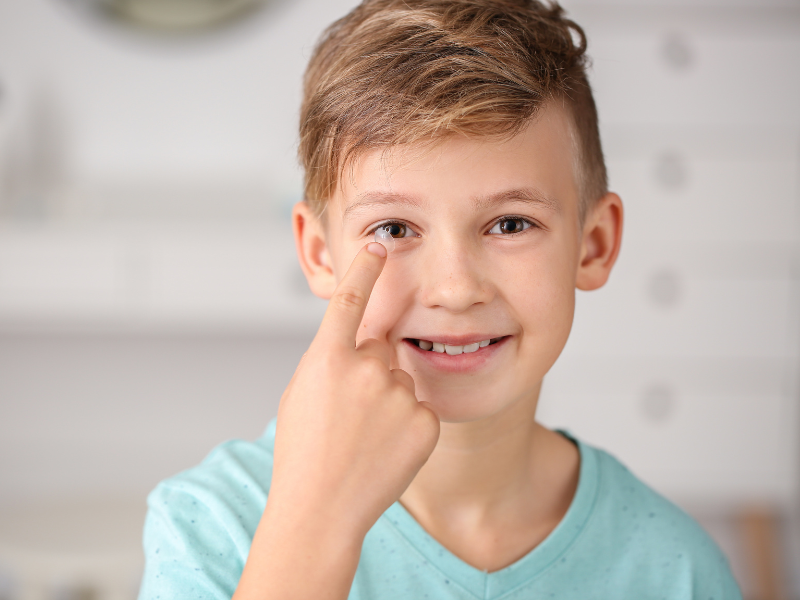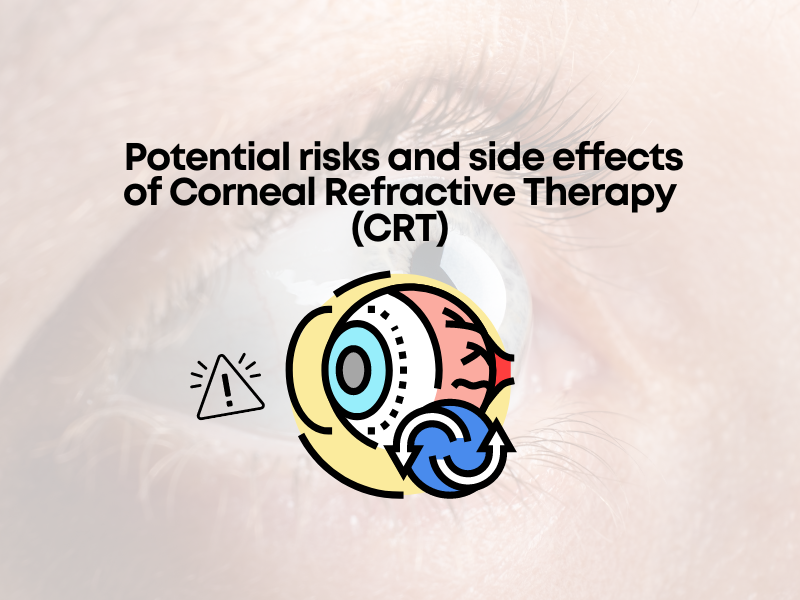Orthokeratology Age Limit: Safe for Kids?
Orthokeratology, also known as Ortho-K, offers a revolutionary approach to vision correction for people of all ages, enabling clear vision without the need for glasses or contact lenses during the day. Although there is no strict age limit, Ortho-K is typically recommended for patients aged six and up, making it suitable for both children and adults pursuing myopia control and vision enhancement. Ortho-K is considered safe for children when proper usage and care guidelines are followed, with studies indicating a low risk of eye infection, similar to soft contact lenses. Metropolitan Optometry offers Ortho-K as a non-surgical, effective solution for myopia management, utilizing advanced technology to create customized lenses for each patient.
Orthokeratology at a Glance
Orthokeratology (Ortho-K) involves wearing specialized contact lenses overnight to reshape the cornea, allowing for clear vision during the day without the need for glasses or contacts.
Ortho-K is generally recommended for patients six years and older, with high safety profiles, comparable to soft contact lenses.
This treatment is effective for myopia control, helping to slow the progression of nearsightedness in children and young adults.
Potential risks include the chance of infection, especially if proper lens hygiene is not maintained.
Ortho-K is most effective for individuals with mild to moderate myopia and astigmatism, typically within a prescription range of -1.00 to -6.00.
Orthokeratology, or Ortho-K, is transforming vision correction for individuals of all ages. At Metropolitan Optometry, we provide Ortho-K as a secure and efficient choice for both children and adults pursuing myopia control and vision enhancement.
What Is Orthokeratology (Ortho-K or CRT)?
Orthokeratology, commonly referred to as Ortho-K or Corneal Refractive Therapy (CRT), is an innovative and non-invasive approach to vision correction and myopia control. It involves the use of specially designed and custom-fitted contact lenses, known as Ortho-K lenses, that work to temporarily reshape the cornea, the clear front surface of the eye.
Ortho-K lenses are worn overnight while sleeping. The lenses apply a controlled shape to the cornea, and when removed in the morning, the wearer can experience significant vision improvement. This process allows for clear, eyeglass-free vision during the day without the need for daytime contact lens wear or prescription glasses.
How Do Ortho-K Lenses Work?
Ortho-K lenses, often referred to as corneal refractive therapy or vision shaping treatment, function in a unique and fascinating manner. They are designed to alter the shape of the cornea, the clear front surface of the eye, while you sleep. This results in clear vision during the day without the need for glasses or daytime contact lenses.
How exactly do these lenses achieve this? The answer lies in innovative design and the principles of physics. The ortho-k lenses float on the tear film that covers the eye's surface. They don't directly touch the cornea, but instead, they apply a gentle hydraulic pressure to the cornea's epithelium, which is the outermost layer of the eye. This pressure subtly shifts epithelial cells from the center of the cornea to the periphery, changing the cornea shape.
Is Ortho-K Safe for Kids?
Safety and Efficacy of CRT in Children
Research shows that orthokeratology (Ortho-K) has a high safety profile in children, with the risk of microbial keratitis infection reported at around 1-2 cases per 2,000 patients wearing years. This safety profile is comparable to that of soft silicone hydrogel contact lenses.
Benefits of Orthokeratology for Children
Ortho-K lenses offer significant benefits for myopia control in children.
By wearing ortho-k lenses overnight, children can enjoy clear vision throughout the day without the need for daytime contact lenses or glasses.
This vision-shaping treatment helps slow the progression of myopia, providing long-term eye health benefits and reducing the need for stronger corrective lenses over time.
Orthokeratology Age Limit
Orthokeratology is suggested for children as young as six years old.
At Metropolitan Optometry, we advocate for initiating myopia management early to attain the best results. Our skilled eye doctors are dedicated to offering safe and effective ortho-k therapies customized to the distinct requirements of each child. We want to address children's vision problems early so that they can experience clear vision and a healthier future for their eyes.
Myopia Management with Corneal Refractive Therapy
Corneal Refractive Therapy is a non-surgical approach to managing myopia progression, especially suitable for children and young adults.
At Metropolitan Optometry, our skilled eye doctors develop customized CRT treatment plans to guarantee the best vision health for your child.
Potential Risks and Side Effects of CRT
While generally safe and effective, CRT has potential risks and side effects. Lens dislodgement during sleep can cause discomfort and require re-insertion. There is a risk of eye infections, such as keratitis, particularly if proper lens hygiene is not maintained. Some users might experience initial discomfort or dryness, especially during the adaptation period, and temporary visual fluctuations can occur if the lenses are not worn consistently.
Improper lens fitting or handling can lead to corneal staining, necessitating a temporary discontinuation of therapy. Additionally, some patients report experiencing glare or halos around lights at night, particularly in low-light conditions.
Proper fitting by an experienced eye care professional, adherence to cleaning and handling protocols, and regular follow-up appointments with our experienced optometrists can help manage and mitigate these risks.
How to Choose the Right Optometrist for Orthokeratology
Bring in Your Child for a Comprehensive Eye Exam
Choosing the appropriate eye doctor for orthokeratology is vital for your child's vision health. At Metropolitan Optometry, our skilled optometrists utilize advanced technology, including a corneal topographer, to map the cornea's shape and curves.
Our devoted team is dedicated to providing exceptional service for your family's complete eye care requirements, making sure your child enjoys the advantages of Ortho-K lenses safely and efficiently. Schedule a comprehensive eye exam today to start your child's journey towards improved vision.
To learn more Ortho-K for kids, reach out to us at 626-839-0908. You can also visit Metropolitan Optometry's main location at 1380 Fullerton Road, Suite 103, Rowland Heights, CA.
Orthokeratology for Kids: FAQs
-
Ortho-K is considered safe for children, provided that proper wear and care systems are diligently followed. Research indicates that continuing Ortho-K wear until at least age 6 is beneficial. Most parents report high satisfaction with the safety and effectiveness of Ortho-K for their children.
-
Ortho-K lenses are suitable for both children and adults, with the best results typically seen in children between 6 and 12 years old. These lenses are effective for correcting light to mild myopia but are not recommended for severe myopia. Most children experience significant vision improvement and myopia control with Ortho-K lenses.
-
Children as young as 6 years old may successfully wear contact lenses, although many eye care providers typically advise against them for children younger than 12 years old due to the risks outweighing the benefits. Some teens may still find it challenging to handle the responsibility, so readiness varies by individual.
-
Most patients with mild to moderate vision issues find Ortho-K to be an excellent option. Individuals with nearsightedness of approximately up to -6.00 diopters (D) can benefit from these lenses. The therapy can also improve lesser degrees of astigmatism, farsightedness, and presbyopia.
-
Children as young as six may be eligible for Ortho-K treatment. This therapy can correct nearsightedness and astigmatism and offers a safe alternative to glasses or daytime contact lenses for people of all ages. Most parents find Ortho-K to be a convenient and effective vision correction method for their young children.
-
One disadvantage of Ortho-K is the time commitment needed for the initial lens fitting and regular follow-up appointments, usually every 3-6 months, to maintain eye health and ideal lens performance. Additionally, Ortho-K does not cure myopia; it only controls its progression. However, for most patients, the advantages of clear vision during the day outweigh the inconveniences.
-
Orthokeratology is effective for nearsighted (myopic) and astigmatic patients, ideally within a prescription range of -1.00 to -6.00, with no more than -1.75 diopters of surface astigmatism. Most patients within these parameters experience significant vision improvement and myopia control with Ortho-K lenses.







